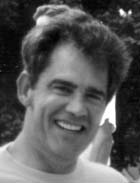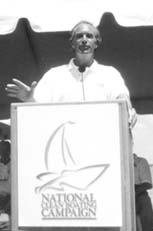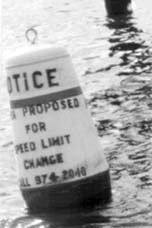
Dock of the Bay

Volume VI Number 28
July 16-22, 1998
Campaign
Trail:
Owings vs. Rooney: Another Pilot Aims at a Political
Pro
Joe Rooney, below at left, hopes to zero in on Delegate George Owings' seat.
Del. George W. Owings III recalls his fateful vote
in the General Assembly six years ago against a tax-increase package shepherded
by then-Gov. William Donald Schaefer. Soon afterward, Schaefer told Owings
that Owings' pet project  -
- an overpass
at Rts. 260 and 2-4 at the Anne Arundel-Calvert County line - was dead.
an overpass
at Rts. 260 and 2-4 at the Anne Arundel-Calvert County line - was dead.
"He was forthright," Owings said of his meeting with fellow-Democrat Schaefer. "He said, 'you wouldn't accommodate me in the tax package I need. I can't accommodate you in your projects.' I understood that."
Owings tells the story to explain why he supported the Ravens stadium and for improvements to pave the way for the Redskins stadium, votes that he will be defending in the coming months when he is challenged in his re-election bid.
Republican Joe Rooney, of Tracey's Landing, a pilot and first-time office-seeker, filed recently to run for Owings' seat.
Owings, a 10-year veteran and a deputy whip in the House of Delegates, said that he backed the stadiums out of fear that Gov. Parris Glendening would once more scuttle his road projects.
"I was darned if I was going to cut off my nose to spite my face one more time," Owings said.
Owings' face is well-known in his sprawling district, which includes portions of southern Anne Arundel, northern Calvert and southern Prince George's counties. It was so well known that Owings received 63 percent of the vote in 1994, a banner Republican year across the country.
Rooney is the second Republican flyer to enter politics this season; Bobby Sturgell, of Owings, is campaigning to unseat Senate President Thomas V. Mike Miller in the same district.
Rooney knows that his campaign is uphill, to say the least. "Everywhere I go, people say, 'you're running against George Owings? You've got a tough battle'. I always say that I know I do," Rooney said.
"I don't have anything bad to say about him; he's a nice guy and everything else. But he's had 10 years to do everything that needs to be done. We certainly didn't marry the guy."
Rooney may not have anything bad to say, but he isn't shy about drawing a few distinctions. He says that unlike Owings, he wouldn't have supported either the Ravens stadium in Baltimore or the tens of millions in improvements to pave the way for the Redskins' new football venue.
Rooney said that he would have pushed for tax breaks with the recent budget surpluses. "You never heard George say a peep about that. He didn't say boo," Rooney says.
Owings scoffs at the notion that the General Assembly was helping the state hoard money. "We did give back the money. We increased school construction to record amounts. We doubled the income tax break to taxpayers," he says.
"The problem with a lot of people is that they've got a mouth full of 'gimmes' and a pocket full of 'much-obligeds'. They really don't understand government to begin with," he added, wondering aloud how long Rooney has lived in the district.
The answer is 10 years. Back in the '80s, Rooney, a native of suburban Philadelphia, was a Marine flyer stationed at Andrews Air Force Base and his wife, Beth Hubert, was a Navy pilot at the Patuxent River Naval Air Test Center. They married and bought a home in Anne Arundel County; they have four children, aged one to nine.
These days, when he's not captaining the Delta shuttle at 30,000 feet between Washington and New York, Rooney is at ground level knocking on doors - 3,200 at last stop. He plans to hit another 3,000 by November.
For months, Rooney has been leaving his Winnebago plastered with his name parked strategically in the 27th District. To some, it has been a clever means of winning name recognition without paying the toll for billboards; to others, Rooney has been junking up the roads and skirting the law that requires prompt removal of broken-down vehicles.
We'll never know what people were thinking when they smashed the back window out of the "Rooneymobile" when it was parked recently near the intersection of Owings prized road project. In another case, Rooney is bringing charges against an Owings man for allegedly destroying a campaign sign valued at $300.
Rooney said that he's enjoying his political campaign and that he isn't deterred by vandals. "It's great fun, and I know that may sound weird because I've got a lot of things I want to do in life," he said.
Owings, too, says that he's having a great time even when answering his critics. "The reason I'm in politics is that I not only live it, I love it," he said.
-BL
Down on the Farm: Sights and Smells of Calvert's Agri-Culture
Find out what Calvert County's all about on a day
at the farm. Five farms from all areas of the county open their gates to
the curious this weekend, offering a cornucopia of agricultural activities.
The idea for a farm tour is not new. "We've been kicking the idea around for several years," said Betty Knapp of Loch Less Farms, one of the event's community organizers. This year a state grant to the Calvert County Agricultural Commission made it happen.
The new farm tour is fun with a purpose. "It's to help newer folks get to know the farmers who have been here for a long time," explained Jim Shepherd of Calvert County Department of Economic Development.
There are more newer folks and fewer farmers all the time, as Calvert's tilled soil gives way to spreading suburbia. "We've probably lost half of our farmland since the 1950s and '60s," says Greg Bowen, the fifth generation of a family of Calvert County farmers and deputy director of planning for the fast-growing county.
The farm tour sets out to lay bridges between Calvert's agrarian roots and its near-suburban present.
Sunday, July 19 is your day - whether you live in Calvert or are just curious - to get to know farmers and their lifestyle. Choose from five diverse farms, or better yet, visit them all. Most have fresh produce for sale; 4-H clubs supply refreshments and demos. Here's who and where:
Stop by during the farm tour for wagon rides every hour on the hour from noon, a corn shelling demo, historical displays of Calvert farming and tobacco, quilts for show and sale, an okra and tobacco stick sale, a petting zoo, a portable saw mill, a beekeeper and hive display, homemade pepper relish, homemade ice cream, 4-H food and a straw pile for kids to play on. 7445 Briscoe's Turn Rd., Owings: At Rt. 4 and Briscoe's Turn Rd.
While on tour, stop in and enjoy forester-guided walking tours of their tree farm, seed cups for the kids, organic vegetables and mushrooms from NuVenture Gardens, music, a beekeeper and a look at their many herbs and perennials. Don't miss the shop full of ways to bring nature home. 4-H members offer refreshment with herbal tea, lemonade, water and baked goods. 4555 Sixes Rd., Prince Frederick: Turn right onto Sixes Rd. off of 2/4 South.
Everybody involved hopes the community-powered family event is a success. "It's like giving a party and not knowing whether anybody's going to come or not," says Knapp. Future tours depend heavily on this year's turnout and on another state grant; so come out, have fun, and help perpetuate Calvert's rich farming heritage.
11-4 all across Calvert County. Tour maps available at all locations; signs mark the way. For more info call 410/257-7012 evenings and weekends or Calvert County Department of Economic Development @ 301/855-1880 · www.co.cal.md.us.
-Mark Burns
Botulism Update: Bad for Ducks; Won't Bother You
If ducks are poisoned by botulism in Rockhold Creek, are fish and crabs safe? That's one of the questions puzzling locals in the wake of July's spread of the avian toxin from three Crofton ponds to the Deale waterway.
Local residents need not worry about their own safety. The local outbreak is type C botulism, according to DNR spokesman Rich McIntire, and doesn't harm humans.
"Typically, type C botulism does not affect humans," confirms Robert Weber, director of Community and Environmental Health at the Anne Arundel County Health Department.
Likewise, fish and crabs are not in danger.
"To our knowledge, fish and crabs are not affected by avian [type C] botulism," says DNR scientist Eric May. "Most fish and crabs will shy away from the area before the toxin accumulates enough to harm them."
But if you want extra reassurance, Weber reminds us that proper cooking temperatures destroys botulism poison in food.
Cook fish and crabs until the internal temperature reaches 160 degrees, advises Noreen Eberly, of Maryland Department of Agriculture's Seafood Marketing Program. Check the temperature by inserting a meat thermometer.
Botulism affects the nervous system, causing increasing muscle weakness to the point of paralysis and eventual death if left untreated. Caused by a potent toxin produced by the bacteria Clostridium botulinum, botulism is not infection but poisoning.
"The bacteria that produces the botulism poison is ubiquitous in the environment," according to Dr. Kimberli Miller, a veterinarian and wildlife disease specialist with the National Wildlife Health Center in Madison, Wis. who has worked all over the country with botulism and other wildlife diseases. "It can survive in a dormant state for years until the environmental conditions are right for the bacteria to grow."
Those conditions, according to Miller, include oxygen-poor water with neutral pH, warm temperatures and an abundant food supply of decayed vegetation or animal carcasses.
In this environment, the bacteria flourish in the sediment, producing the botulism toxin as a byproduct of their normal metabolism. It's the old familiar summer stew of too much algae, too little oxygen.
Ducks first come in contact with the poison by rooting around in the sediment for food, says May. Untreated, these ducks die, often drowning because the toxin blocks nerve impulses and they can't lift their heads out of the water.
"The poison then spreads by way of the maggot cycle," explains Miller. "Maggots feed on the botulism-tainted carcasses. The maggots are not affected, but they store the poison in their bodies. Other ducks are poisoned when they eat the maggots."
The ducks recover from the poisoning if treated in time. "At last count, we've treated 19 live ducks and 15 survived." says Greg Lawrence, director of avian care at the Chesapeake Wildlife Sanctuary. "If you see a sick duck box it up and bring it to us, but call first," he advises. "We're open for admissions every day and don't require appointments."
Even though this type of botulism is not dangerous for people or their pets, Lawrence recommends a certain amount of caution. "For safety's sake, I would minimize contact with sick animals. Don't let your dog harass a sick duck. Wash your hands carefully after handling a sick animal. Botulism is not contagious, but a sickly animal could have secondary problems."
In stagnant ponds of water, flushing with fresh water alleviates the conditions that lead to botulism contamination. But in natural waterways such as Rockhold Creek, the situation must simply run its course with the tides. The only thing to do, according to May, is wait it out until the bacteria's food supply is gone or the oxygen levels in the water increase.
Reach Chesapeake Wildlife Sanctuary at 301/390-7010.
-Kim Cammarata
Shady Side: Old Adversaries To Join Hands; Dirty Them, Too
The land-use battle on the Shady Side Peninsula in Southern Anne Arundel has been long and fierce, with both sides suffering casualties along the way.
But on July 18, from 10am until noon, combatants in the fight over the Baldwin's Choice subdivision will lay aside their rhetoric and their rancor and join forces in a campaign to build a park, rather than houses, on 477 acres of precious land.
In the short term, a trash-strewn road in Columbia Beach, a predominately African American community, will get a good cleaning.
"This will be the first time that all of the players who are part of the deal to save this land will be in the same place at the same time," said Michael Shay, of South Arundel Citizens for Responsible Development, or SACReD. "When they leave, it will be a done deal."
That's Shady Side's hope, anyway. The deal in question is a proposed partnership between the state, county and private groups to buy the waterfront tract. Developer Dominic Antonelli, the Washington parking magnate, said that he would sell his land for the park rather than pursue plans to build luxury homes, New Bay Times disclosed this spring.
SACReD, which has spearheaded opposition to Baldwin's Choice, has taken a conciliatory tone in the wake of a grueling defamation trial on a $50 million lawsuit brought by Antonelli. The group and its members avoided damages although a jury said they had made untrue statements about Antonelli.
The display of unity is more than an attempt to heal old wounds: It is a drive to shake loose about $6 million from state, county and possibly other sources to buy the land.
County Executive John Gary, who plans to attend the unity gathering, has said that he will contribute money for the purchase. Gov. Parris Glendening also has promised to take part and has commissioned a state appraisal.
Jeffrey Harris, Antonelli's chief lawyer, said that he plans to stand in for Antonelli in Shady Side. Antonelli had plans to be out of town.
"Mr. Antonelli goes back a long way on this property; he had a house there," Harris said. "He hopes that this sale works out. Obviously, he can not lose sight of his responsibility to the shareholders of the corporation. He is hoping that the economic outcome is satisfactory. If that can be accomplished with public use of the land that the public supports, that would be all the better."
Organizers want memorable turnout by the public to persuade the political leaders that the park has broad support. Said Shay: "We want people to come out and see what may soon be their new park."
But there's a price of admission: helping clean up Columbia Beach Road, where people will gather for the two-hour event. Gus Jackson, of Columbia Beach, referred to the proposed park as the end of a long struggle that has split his community.
"There always has been an unswerving commitment here to preserving our heritage and our natural community," Jackson said. "It's been a struggle, and with SACReD's help, it has culminated in the kind of success that we never anticipated."
-BL
In Rose Haven, Nation's Clean Boating Program Shoves Off
U.S. Senator Dirk Kempthorne, R-Idaho, below, praised clean boating as it calls for no new regulations.
Steuart Chaney, who operates Herrington Harbour
Marinas, told a national gathering about a curious by-product of clean boating:
a boat-owner named Barry McCahill who talks to a great blue heron that has
take n up residence at Herrington
South.
n up residence at Herrington
South.
"I'm getting a little bit concerned about our slip-holders; we may have to re-evaluate our list next year," Chaney joked.
The heron, it turns out, was standing not 50 yards away, in the shadow of the sprawling white tents where Chaney hosted political, environmental and boating industry leaders last weekend for the kickoff of the National Clean Boating Campaign.
Keeping sewage, oil and boating wastes under control may seem like common sense in 1998. But the fact remains that many of the 70 million Americans who boat don't grasp the connection between smart boating practices and floating atop clean and safe water.
To remedy the problem, an uncommonly broad alliance of government types, conservationists and boating business leaders - 618 government agencies or businesses in 43 states and territories - has spent $200,000 so far on a campaign to teach people on the water to wise up.
The Chesapeake's own Herring Bay was ground zero in the entire country for the new effort. A modest turn-out of 200 on the flawless, blue morning did not do justice to a project of such scope.
"This is something we will look back at years from now and say what a wonderful initiative it was," said Phil Keeter, campaign chairman.
U.S. Sen. Dirk Kempthorne, R-Idaho, observed that the partnership satisfied a key criteria of support from the Republican-held Congress: It avoids new regulations. Like others who made speeches, Kempthorne appeared to be caught up in the splendor of the gorgeous day.
"We all dream about those days when we're going to be able to go off to those pristine waters, go snorkeling," Kempthorne said, his mind seemingly off in the Caribbean. Until then, he hastened to add, our oceans and bays will have to do - and it is our duty to keep them as clean as possible.
Boats contribute only a portion of the oily wastes and the nutrients from sewage that foul the Bay. But in Maryland, there are plenty of boats to contribute: 250,000 at 550 marinas, said Verna Harrison, assistant director at the Department of Natural Resources.
Harrison announced at the gathering a new DNR Clean Marina Award campaign will use a federal grant to give certifications to marinas that submit to inspections.
Chesapeake Bay Commission's Ann Swanson got to the heart of a boat waste problem: "It's very uncomfortable to my friends if I use their head and I say, 'Hey, where is this going'?"
While pump-out stations for boat sewage may seem like old hat, just 2,200 of them exist from coast to coast. In Maryland, Steuart Chaney's 20-year old marina was the first to install a pump-out, and he told the tangible success of the experience last year alone: 25,000 gallons of raw sewage that might otherwise have ended up in the Chesapeake Bay.
Tips For Boaters, Fishermen and Marinas
For Boaters
For Fishermen
For Marinas
-NBT
In Anne Arundel, PeopleSay No-Wake,
For Heaven's Sake
photo by Bill Lambrecht A buoy in A.A. County's Rockhold Creek gives notice of proposed speed changes.
Jet-skis and speeding vessels are getting to be too much for many people along the shore to handle.
The Department of Natural Resources has received petitions seeking to reduce boat speeds at three locations in Southern Anne Arundel:
In each case, DNR is conducting surveys to see if the change should be ordered. Property owners with opinions should send their written comments to Capt. W. David Street, Commander of Safety Education, Maryland Natural Resources Police, 69 Prince George St. Annapolis, Md 21401.
-NBT
In Wisconsin, the town of Horicon holds an annual festival celebrating Canada geese. That's why it strikes us as odd that police are searching for a hit-and-run driver who deliberately ran down 18 Canadas in his vehicle, killing them ...
Ukraine health officials warned to avoid mushrooms and berries from street vendors after finding high readings of Cesium-137 and Strontium-90 ---dangerous radioactive pollution from the fallout of the Chernobyl nuclear plant explosion 12 years ago
Mississippi ain't the let-it-all-hang-out French Riviera. But someone is using the Internet to change the name of the barrier islands to the BAREier Islands by promoting nude sunbathing. Along Gulf Islands National Seashore, rangers are on the lookout for a rise in the number of bare bottoms on the beach ...
In Honolulu, the Star-Bulletin newspaper gets our "I'll Be Darned" prize of the week. The paper reports that enzymes from bacteria feasting on rotting whale carcasses on the ocean floor hold promise as a cold-water detergent that will dissolve greasy stains ...
Our Creature Feature comes from Kentucky, where researchers say that the threat of extinction of the Indiana bat could be an important warning to humans.
The mouse-sized mammal continues to disappear from the Midwest and Eastern United States at an alarming pace. Their number has shrunk by two-thirds in recent decades to just 250,000, prompting desperate methods to save them, the Lexington (Ken.) Herald-Leader reports. A federal judge prohibited logging in the Daniel Boone National Forest. Foresters have installed gates across the entrance of hibernation caves to keep people away and are considering a controlled burn of pine trees to loosen bark for the bats.
Biologist John MacGregor noted that the bats' physiology is similar to humans. "If there are things out there that are messing up the reproductive cycle of bats, they're probably also going to mess up the reproductive cycles of humans," he said.
| Back to Archives |
Volume VI Number 28
July 16-22, 1998
New Bay Times
| Homepage |